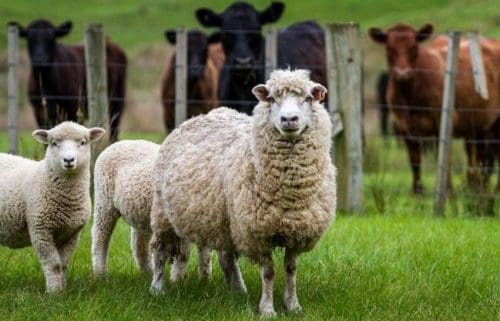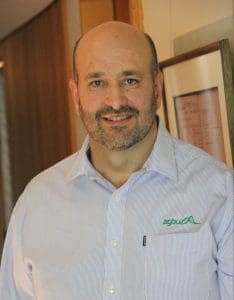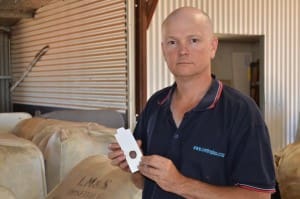
AUSTRALIA does not have a national livestock gene bank as insurance against an exotic disease incursion two years after the initiative was first considered by the previous Coalition Government.
Valuable livestock genetics can be lost as unexpected incursions of exotic diseases like Foot and Mouth Disease and Bovine spongiform encephalopathy (Mad Cow Disease) prompt culling protocols requiring quick disposal of all animals on a property to limit infection spread.

AGBU director Dr Stephen Miller.
Animal Genetics and Breeding Unit director Stephen Miller has told Sheep Central the storage of genetic material by individual breeders would be one way to mitigate the risk, but he believes Australia needs a national strategy on the issue.
“These national programs are all about rebuilding the country.
“I concur that a wholesale putting down of a breeders herd/flock can be quite devastating,” he said.
“They have spent a lifetime building their herd and in some cases cannot be rebuilt /replaced.
“I have seen it happen in Canada, if you are unfortunate enough to be identified as a herd that needs to be depopulated, it all happens very fast,” Mr Miller said.
“You don’t have time to say, wait a minute I want to flush a few females first.
“They are just gone.”
Dr Miller said he has been told the Federal Department of Agriculture, Water and the Environment has been considering the business case for a National Livestock Gene Bank since 2020.
He was told the department also engaged CSIRO to conduct a feasibility study on different options for the National Livestock Gene Bank, motivated by the need for disaster recovery from an animal disease emergency or natural disaster. Stakeholders from Australia’s livestock industries and the RD&E sector were consulted.
A DAWE spokesperson told Sheep Central today that in July 2021 the department commissioned CSIRO to develop a business case for a livestock gene bank.
“This project was to provide appropriate models for an Australian facility, taking stakeholder consultation into consideration.
“Their report is nearing finalisation and will be published on the CSIRO website once complete,” the spokesperson said.
“The livestock gene bank was an initiative of the previous government and has not been prioritised for implementation by the new government.”
Littleproud made last-minute gene bank promise
In a pre-election commitment release on April 24 2022 that did not stipulate a funding component, former Minister for Agriculture David Littleproud said gene banks were a way of future-proofing Australian agriculture.
“It is only a Liberal and National government that has the foresight to put this gene bank in place to protect our livestock industry,” he said.
“Ensuring that our farmers can rebound after an environmental disaster or disease outbreak and improve our research capabilities supports the agricultural industry’s goal of $100 billion in farm gate value by 2030,” Mr Littleproud said.
National identification system saved Canada
Dr Miller said although he is not a geneticist nor a veterinarian, he has lived and worked in other countries, such as home country Canada was a cattle owner there during a BSE outbreak.
“I can still remember where I was when I learned there had been a confirmed case of BSE.
“It just comes out of the blue and your whole world changes,” he said.
“The saviour for Canada was that they put a national identification system in place years earlier.
“I remember when it came in some farmers were quite vocally opposed. It was interesting that after BSE those negative voices quickly faded,” Dr Miller said.
“Everyone was glad the system was in place to trace and get on top of the problem quickly.
“I also worked in New Zealand for a while and saw how problematic TB was in that country.”
Dr Miller said in Canada and the USA there are national programs to preserve germplasm.
“I was fortunate to tour the USDA facility in Fort Collins CO.
“This was a very impressive investment. You can learn more about that project here.”
Sheep Central has contacted Mr Littleproud and the current Minister for Agriculture Murray Watt for comment.
Merino breeder recognises his female genetics would be at risk

Merino breeder Mark Mortimer.
National Livestock Genetics Consortium member, Merino breeder Mark Mortimer supports establishment of a national livestock gene bank.
He believes a gene bank is a sound risk management strategy, and there are other benefits.
“It becomes a resource as well as being a gene bank.”
“Given the current increased threat level, it seems very sensible that we should be progressing something.
“We’ve seen what other countries have done, they are not just playing copycat, there are solid reasons for why they are doing that.”
As owner of the Centre Plus Merino Stud, Mr Mortimer recognises that his flock is not adequately protected against the genetic losses potentially involved with an exotic disease outbreak.
“We have some level of protection, we always have stored genetics (semen), but if Foot and Mouth Disease was to hit, you would want your maternal and paternal lines (protected), females and males and that would be frozen embryos.
“That greatly changes the cost structure of your risk mitigation.”
Mr Mortimer said most stud breeders would be storing semen from sires, but the deficit is in the level of current protection of his female genetics. He agreed not have any eggs or embryos from his top females in storage meant his flock might be exposed in the event of an exotic disease incursion.
“Absolutely … it’s full exposure to 50 percent of your genetics.”
Click here to read what Victoria’s former Chief Veterinary Officer Charles Milne thinks about gene banks.

For performance genetics we currently rely on, grants to kick start breeding companies into routine banking of embryos and refreshing the bank would be a great idea.
Rare breeds etc could be a national bank, but for selective programs they need to be part of the program itself.
Breeding programs need to be nimble to keep genetics updated and this is best done by the breeding companies themselves. Empowerment is the key.